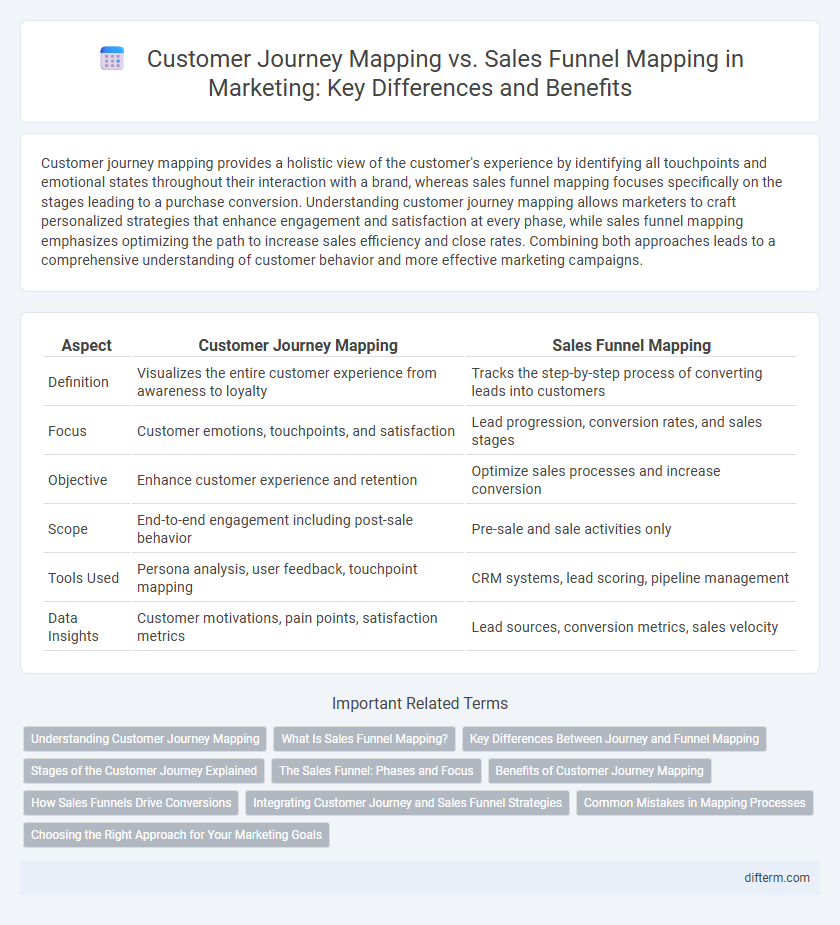Customer journey mapping provides a holistic view of the customer's experience by identifying all touchpoints and emotional states throughout their interaction with a brand, whereas sales funnel mapping focuses specifically on the stages leading to a purchase conversion. Understanding customer journey mapping allows marketers to craft personalized strategies that enhance engagement and satisfaction at every phase, while sales funnel mapping emphasizes optimizing the path to increase sales efficiency and close rates. Combining both approaches leads to a comprehensive understanding of customer behavior and more effective marketing campaigns.
Table of Comparison
| Aspect | Customer Journey Mapping | Sales Funnel Mapping |
|---|---|---|
| Definition | Visualizes the entire customer experience from awareness to loyalty | Tracks the step-by-step process of converting leads into customers |
| Focus | Customer emotions, touchpoints, and satisfaction | Lead progression, conversion rates, and sales stages |
| Objective | Enhance customer experience and retention | Optimize sales processes and increase conversion |
| Scope | End-to-end engagement including post-sale behavior | Pre-sale and sale activities only |
| Tools Used | Persona analysis, user feedback, touchpoint mapping | CRM systems, lead scoring, pipeline management |
| Data Insights | Customer motivations, pain points, satisfaction metrics | Lead sources, conversion metrics, sales velocity |
Understanding Customer Journey Mapping
Customer journey mapping captures the comprehensive experience and emotions customers undergo across all touchpoints, providing deep insights into their motivations and pain points. It focuses on understanding the full lifecycle from awareness to loyalty, enabling personalized marketing strategies that enhance customer satisfaction and retention. This holistic approach differs from sales funnel mapping, which primarily tracks conversion stages to optimize sales performance.
What Is Sales Funnel Mapping?
Sales funnel mapping visualizes the sequential stages customers pass through from awareness to purchase, emphasizing conversion rates and sales performance at each step. It highlights key metrics such as lead generation, prospect engagement, and closing rates, enabling marketers to optimize sales strategies and increase revenue. Unlike customer journey mapping, sales funnel mapping focuses specifically on driving sales outcomes through targeted funnel stage analysis.
Key Differences Between Journey and Funnel Mapping
Customer journey mapping emphasizes the entire customer experience across multiple touchpoints, capturing emotions, motivations, and interactions over time. Sales funnel mapping focuses specifically on the conversion process, illustrating stages from lead generation to purchase and optimizing for sales outcomes. Key differences include journey mapping's holistic view versus funnel mapping's goal-oriented structure, with journey maps driving customer-centric strategies and funnels targeting revenue growth.
Stages of the Customer Journey Explained
Customer journey mapping outlines key phases such as awareness, consideration, decision, retention, and advocacy, providing a detailed view of customer experiences across touchpoints. Sales funnel mapping concentrates on the linear progression through stages like lead generation, prospect qualification, proposal, and closing, emphasizing conversion metrics. Understanding these distinct frameworks helps marketers optimize engagement strategies by aligning messaging and resources with specific customer behaviors at each stage.
The Sales Funnel: Phases and Focus
The sales funnel narrows through distinct phases: awareness, interest, decision, and action, emphasizing converting prospects into customers by guiding them step-by-step. Each phase targets specific objectives, such as lead generation in awareness and closing deals during the decision phase, optimizing marketing efforts for maximum conversion. By focusing on these stages, businesses can streamline sales activities, measure conversion rates, and identify bottlenecks within the buying process.
Benefits of Customer Journey Mapping
Customer journey mapping provides a comprehensive view of customer interactions across multiple touchpoints, enabling marketers to tailor personalized experiences that increase engagement and loyalty. It uncovers pain points and emotional triggers, allowing businesses to optimize every stage of the journey for higher satisfaction and conversion rates. Unlike sales funnel mapping, which focuses primarily on transactional stages, customer journey mapping integrates behavioral data and customer feedback for more strategic, long-term relationship building.
How Sales Funnels Drive Conversions
Sales funnels drive conversions by systematically guiding potential customers through stages of awareness, interest, decision, and action, optimizing each touchpoint to reduce drop-offs. Unlike customer journey mapping that explores broad interactions across multiple channels, sales funnel mapping targets specific conversion-focused behaviors and metrics. This precise approach enables marketers to identify bottlenecks and implement targeted strategies to increase leads, nurture prospects, and accelerate purchase decisions.
Integrating Customer Journey and Sales Funnel Strategies
Integrating customer journey mapping with sales funnel strategies enhances personalized marketing efforts by aligning touchpoints with conversion stages, enabling a holistic understanding of customer behavior. This integration facilitates seamless transitions from awareness to purchase by identifying key interactions and optimizing engagement channels based on real-time data. Leveraging both methods drives higher conversion rates and improves customer retention through targeted, data-driven campaigns.
Common Mistakes in Mapping Processes
Common mistakes in customer journey mapping and sales funnel mapping include oversimplifying complex customer behaviors and ignoring emotional triggers that influence decision-making. Marketers often rely too heavily on linear models, failing to account for multi-channel interactions and feedback loops critical for accurate mapping. Neglecting to update maps with real-time data leads to misaligned strategies and missed opportunities for personalized engagement.
Choosing the Right Approach for Your Marketing Goals
Customer journey mapping emphasizes understanding customers' experiences and emotions across touchpoints, helping marketers create personalized strategies that boost engagement and loyalty. Sales funnel mapping focuses on tracking the step-by-step conversion process, optimizing lead generation and closing rates for revenue growth. Selecting the right approach depends on whether your goal is to enhance customer experience or to streamline the sales process for measurable financial outcomes.
customer journey mapping vs sales funnel mapping Infographic

 difterm.com
difterm.com